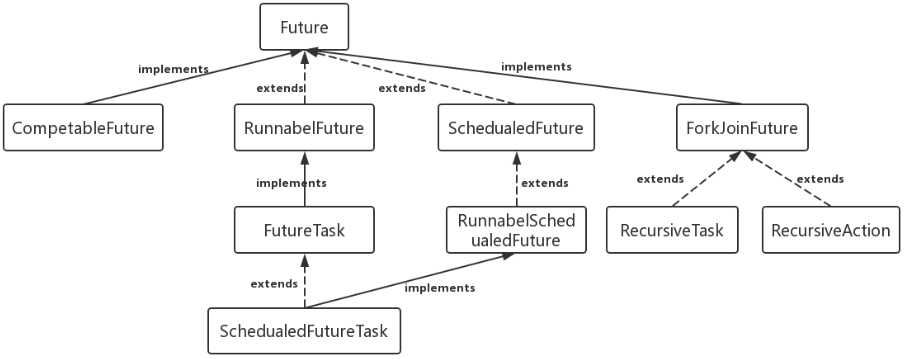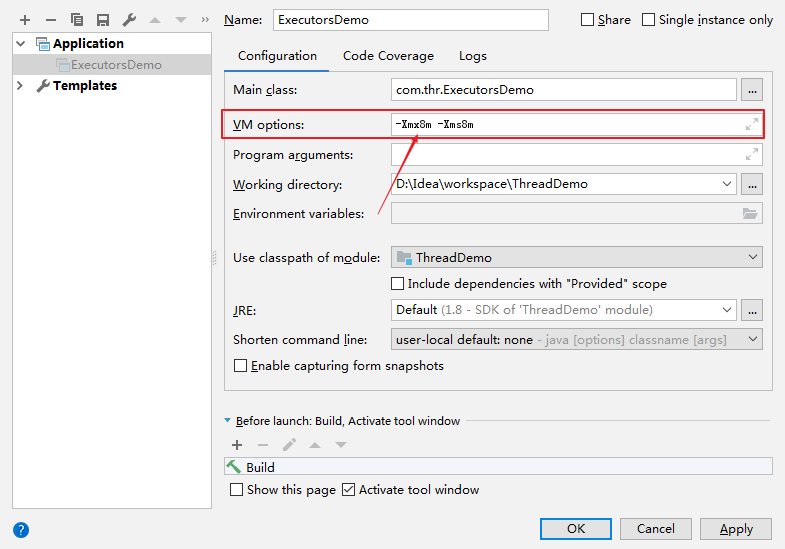本文介绍另外两种创建多线程的方式,这两种方式我们在实际中会用的多一点,尤其是线程池。而在前面文章中我们讲述了创建线程最基本的两种方式:一种是直接继承Thread,另外一种就是实现Runnable接口。但是这两种方式创建线程有一个缺陷,那就是无法获取到线程运行后的结果,因为这两个方式都是重写了 run()方法,而run()方法是用void修饰的。所以后来就有了Callable和Future这两个接口,它们能够获取线程执行的结果。
1、Callable
Callable是在JDK1.5中出现的接口,它和Runnable接口很相似,我们可以认为:Callable接口是Runnable接口的增强版,因为Runnable有的功能Callable都有,而且还能获取任务执行的结果。所以下面我们来看一下Callable和Runnable接口的对比:
先来看一下Runnable接口的源码:
public interface Runnable { public abstract void run(); }
Callable接口的源代码:
public interface Callable<V> { V call() throws Exception; }
可以很明显的看出它们二者的区别:
- Callable使用的是call(),而Runnable中使用的是run()。
- Callable的call()可以抛出异常,而Runnable的run()不会抛出异常。
- Callable能接受一个泛型,然后在call()中返回一个这个类型的值。而Runnable的run()没有返回值。
我们上面说Callable是可以返回任务执行结果的,而获取返回结果需使用到Future。所以下面要介绍一下Future。
2、Future
Future也是一个接口,通过它可以获得任务执行的返回值。该接口的内部源码如下:
public interface Future<V> { boolean cancel(boolean mayInterruptIfRunning); boolean isCancelled(); boolean isDone(); V get() throws InterruptedException, ExecutionException; V get(long timeout, TimeUnit unit) throws InterruptedException, ExecutionException, TimeoutException; }
可以发现在Future接口中声明了5个方法,下面依次解释每个方法的作用:
- cancel方法用来取消任务,如果取消任务成功则返回true,如果取消任务失败则返回false。参数mayInterruptIfRunning表示是否允许取消正在执行却没有执行完毕的任务,如果设置true,则表示可以取消正在执行过程中的任务。如果任务已经完成,则无论mayInterruptIfRunning为true还是false,此方法肯定返回false,即如果取消已经完成的任务会返回false;如果任务正在执行,若mayInterruptIfRunning设置为true,则返回true,若mayInterruptIfRunning设置为false,则返回false;如果任务还没有执行,则无论mayInterruptIfRunning为true还是false,肯定返回true。
- isCancelled方法表示任务是否被取消成功,如果在任务正常完成前被取消成功,则返回 true。
- isDone方法表示任务是否已经完成,若任务完成,则返回true;
- get()方法用来获取执行结果,这个方法会产生阻塞,会一直等到任务执行完毕才返回;
- get(long timeout, TimeUnit unit)用来获取执行结果,如果在指定时间内,还没获取到结果,就会抛出TimeoutException异常(慎用这个方法,因为有很多坑)。
下面是Future接口中在java.util.concurrent包下类的结构图:

由于Future只是一个接口,所以是无法直接用来创建对象使用的,所以真正获取结果用到的是FutureTask这个类。
FutureTask
通过上面的图片发现FutureTask类是实现了RunnableFuture接口,而这个接口又继承了Future接口,我们具体点开其源码来看。
public class FutureTask<V> implements RunnableFuture<V>{ code... }
打开RunnableFuture接口的实现:
public interface RunnableFuture<V> extends Runnable, Future<V> { void run(); }
可以看出RunnableFuture继承了Runnable接口和Future接口,而FutureTask实现了RunnableFuture接口。所以它既可以作为Runnable被线程执行,又可以作为Future得到Callable的返回值。
上面说了这么多,接下来使用Callable+FutureTask创建线程并获取执行结果的一个栗子如下:
- 创建一个实现Callable接口的类。
- 重写call方法,将线程要执行的操作定义在call()中。
- 创建Callable接口实现类的对象。
- 创建FutureTask对象,并将上面Callable接口实现类的对象传入FutureTask构造器中。
- 将FutureTask的对象作为参数传入Thread类的构造器中,创建Thread类对象,并且启动线程。
- 获取Callable中call方法的返回值。
package com.thr; import java.util.concurrent.Callable; import java.util.concurrent.ExecutionException; import java.util.concurrent.FutureTask; /** * @author Administrator * @date 2020-04-09 * @desc Callable+Future创建并获取线程执行结果 */ //1、创建一个实现Callable接口的类 class MyCallable implements Callable<Integer>{ //2、重写call方法,将线程要执行的操作定义在call()中 @Override public Integer call() throws Exception { int num=0; for (int i = 1; i <= 100; i++) { num+=i; } return num; } } public class CallableFutureDemo { public static void main(String[] args) { //3、创建Callable接口实现类的对象 MyCallable callable = new MyCallable(); //4、创建FutureTask对象,并将上面Callable接口实现类的对象传入FutureTask构造器中 FutureTask<Integer> task = new FutureTask<Integer>(callable); //5、将FutureTask的对象作为参数传入Thread类的构造器中,创建Thread类对象,并且启动线程 new Thread(task).start(); try { //6、获取Callable中call方法的返回值 Integer integer = task.get(); System.out.println(integer); } catch (InterruptedException e) { e.printStackTrace(); } catch (ExecutionException e) { e.printStackTrace(); } } }
我们知道Callable用于产生结果,Future用于获取结果。不过Callable和Future一般都和线程池搭配使用,所以下面再来简单介绍一下线程池的使用。
3、线程池
在前面的文章中我们介绍了Thread、Runnable和Callable这三种方式创建线程,我在创建少量线程的时候使用它们是非常的简单方便的,但是如果我们需要创建成百上千的线程时,那么岂不是要创建成百上千个线程对象,调用成百上千的start()方法,可见这样是非常浪费时间、消耗资源和降低程序效率的。那么为了解决这一问题就出现了线程池。
线程池顾名思义,就是由很多线程构成的池子。在有任务的时候随时取用线程,当任务完成后又将线程放回池中。
所以合理利用线程池能够带来三个好处。
- 降低资源消耗。通过重复利用已创建的线程降低线程创建和销毁造成的消耗。
- 提高响应速度。当任务到达时,任务可以不需要等到线程创建就能立即执行。
- 提高线程的可管理性。线程是稀缺资源,如果无限制的创建,不仅会消耗系统资源,还会降低系统的稳定性,使用线程池可以进行统一的分配,调优和监控。
线程池的创建一般用Executors这个工具类来创建,常见的有以下四种方式:
- newFixedThreadPool(int nThreads):创建一固定线程数目的线程池,超出的线程会在队列中等待。
- newSingleThreadPoolExecutor():创建一个单线程化的线程池。它只会用唯一的工作线程来执行任务,保证所有任务按照指定顺序(FIFO, LIFO, 优先级)执行。
- newCacheThreadPool():创建一个可缓存的线程池。如果现有线程没有可用的,则创建一个新线程并添加到缓存池中。如果有被使用完但是还没销毁的线程,就复用该线程。如果有线程60s未被使用的话就会从缓存中移出并终止。因此,长时间保持空闲的线程池不会使用任何资源。
- newScheduledThreadPool(int corePoolSize):创建一个支持定时及周期性的任务执行的线程池,多数情况下可用来替代Time类。
但是并不推荐使用Executors来创建,因为可能会出现OOM(Out Of Memory,内存溢出)的情况,下面我们依次详细的分析这四个方式:
①、Executors.newFixedThreadPool(int nThread)
public static ExecutorService newFixedThreadPool(int nThreads) { return new ThreadPoolExecutor(nThreads, nThreads, 0L, TimeUnit.MILLISECONDS, new LinkedBlockingQueue<Runnable>()); }
可以发现最后一行使用了LinkedBlockingQueue,泛型是Runnable类型,这里的队列是用来存放任务的。我们再来看看这个LinkedBlockingQueue部分源码:
public LinkedBlockingQueue() { this(Integer.MAX_VALUE); } public LinkedBlockingQueue(int capacity) { if (capacity <= 0) throw new IllegalArgumentException(); this.capacity = capacity; last = head = new Node<E>(null); }
在上一章博客中提过LinkedBlockingQueue是链表实现的有界阻塞队列,其capacity是可以选择进行设置的,如果不设置的话,将是一个无边界的阻塞队列,队列的最大长度为Integer.MAX_VALUE。而上面newFixedThreadPool的源码中,我们可以很清晰的看到LinkedBlockingQueue是没有指定capacity的。所以此时LinkedBlockingQueue就是一个无边界队列,对于一个无边界队列来说,是可以不断的向队列中加入任务的,这种情况下就有可能因为队列中等待的线程数太多而导致OOM。
下面我们来一个简单的例子,模拟一下使用Executors导致OOM的情况:
首先将JVM参数调一下:-Xmx8m –Xms8m

代码如下:
package com.thr; import java.util.concurrent.ExecutorService; import java.util.concurrent.Executors; /** * @author Administrator * @date 2020-04-11 * @desc Excutors出现OOM举例 */ public class ExecutorsDemo { private static ExecutorService service = Executors.newFixedThreadPool(15); public static void main(String[] args) { for (int i = 0; i < Integer.MAX_VALUE; i++) { service.execute(new SubThread()); } } } class SubThread implements Runnable { @Override public void run() { try { Thread.sleep(10); } catch (InterruptedException e) { //do nothing } } }
运行结果:

②、Executors.newSingleThreadExexutor()
public static ExecutorService newSingleThreadExecutor() { return new FinalizableDelegatedExecutorService (new ThreadPoolExecutor(1, 1, 0L, TimeUnit.MILLISECONDS, new LinkedBlockingQueue<Runnable>())); }
可以发现还是使用阻塞队列LinkedBlockingQueue,所以问题是一样的。
③、Executors.newCacheThreadPool()
public static ExecutorService newCachedThreadPool() { return new ThreadPoolExecutor(0, Integer.MAX_VALUE, 60L, TimeUnit.SECONDS, new SynchronousQueue<Runnable>()); }
可以发现ThreadPoolExecutor对象中的第二个参数为Integer.MAX_VALUE,而这个位置参数的意思为线程池最大线程数。所以还是会出现OOM的情况。
④、Executors.newScheduleThreadPool()
public static ScheduledExecutorService newScheduledThreadPool(int corePoolSize) { return new ScheduledThreadPoolExecutor(corePoolSize); } public ScheduledThreadPoolExecutor(int corePoolSize) { super(corePoolSize, Integer.MAX_VALUE, 0, NANOSECONDS, new DelayedWorkQueue()); } public class ScheduledThreadPoolExecutor extends ThreadPoolExecutor implements ScheduledExecutorService { code... }
通过上面三段代码可以发现newScheduleThreadPool()方法返回了ScheduledThreadPoolExecutor对象,而它又继承了ThreadPoolExecutor类,并且调用的是父类的构造器,而构造器中的第二个参数为Integer.MAX_VALUE,所以还是同样的问题。
这就是使用Executors工具类创建线程池的缺陷所在,在《阿里巴巴开发手册》中是不建议使用这种方式创建线程池的,而是推荐使用new ThreadPoolExecutor构造函数来创建线程池。如果你细心一点会发现上面四种方式中其实最终都是使用ThreadPoolExecutor这个类,所以这个类才是线程池的核心,我们只有彻底了解这个类才能真正的理解线程池。

4、ThreadPoolExecutor
上面既然说推荐使用ThreadPoolExecutor来创建线程池,那么先来看一下ThreadPoolExecutor的内容。在ThreadPoolExecutor类中提供了四个构造器,由于前三个构造器其实都是调用了第四个构造器来完成初始化的,所以这里就列出第四个构造器:
public ThreadPoolExecutor(int corePoolSize, int maximumPoolSize, long keepAliveTime, TimeUnit unit, BlockingQueue<Runnable> workQueue, ThreadFactory threadFactory, RejectedExecutionHandler handler) { if (corePoolSize < 0 || maximumPoolSize <= 0 || maximumPoolSize < corePoolSize || keepAliveTime < 0) throw new IllegalArgumentException(); if (workQueue == null || threadFactory == null || handler == null) throw new NullPointerException(); this.acc = System.getSecurityManager() == null ? null : AccessController.getContext(); this.corePoolSize = corePoolSize; this.maximumPoolSize = maximumPoolSize; this.workQueue = workQueue; this.keepAliveTime = unit.toNanos(keepAliveTime); this.threadFactory = threadFactory; this.handler = handler; }
可以发现构造器有7个参数,下面分别解释下构造器中各个参数的含义:
- corePoolSize:核心池的大小。在创建了线程池后,默认情况下,线程池中并没有任何线程,而是等待有任务到来才创建线程去执行任务,除非调用了prestartAllCoreThreads()或者prestartCoreThread()方法,从这2个方法是预创建线程的意思,即在没有任务到来之前就创建corePoolSize个线程或者一个线程。默认情况下,在创建了线程池后,线程池中的线程数为0,当有任务来之后,就会创建一个线程去执行任务,当线程池中的线程数目达到corePoolSize后,就会把到达的任务放到缓存队列当中。
- maximumPoolSize:线程池最大线程数,这个参数也是一个非常重要的参数,它表示在线程池中最多能创建多少个线程。
- keepAliveTime:空闲线程的存活时间。就是当线程的数量大于corePoolSize时,如果等待了keepAliveTime时长还没有任务可执行,则线程终止(前提是线程池中的线程数必须大于corePoolSize时,keepAliveTime才会起作用),直到线程池中的线程数不超过corePoolSize。但是如果调用了allowCoreThreadTimeOut(boolean)方法,在线程池中的线程数不大于corePoolSize时,keepAliveTime参数也会起作用,直到线程池中的线程数为0。
- unit:参数keepAliveTime的时间单位,它在TimeUnit类中有7种静态属性可取。
TimeUnit.DAYS; //天 TimeUnit.HOURS; //小时 TimeUnit.MINUTES; //分钟 TimeUnit.SECONDS; //秒 TimeUnit.MILLISECONDS; //毫秒 TimeUnit.MICROSECONDS; //微妙 TimeUnit.NANOSECONDS; //纳秒
- workQueue:一个阻塞队列,用来存储等待执行的任务,这个参数的选择也很重要,会对线程池的运行过程产生重大影响,一般来说,这里的阻塞队列有以下几种选择:
ArrayBlockingQueue:是一个基于数组结构的有界阻塞队列,此队列按FIFO(先进先出)原则对元素进行排序。 LinkedBlockingQueue:一个基于链表结构的阻塞队列,此队列按FIFO排序元素,吞吐量通常要高于ArrayBlockingQueue,静态工厂方法Executors.newFixedThreadPool()使用了这个队列。 SynchronousQueue:一个不存储元素的阻塞队列。每个插入操作必须等到另一个线程调用移除操作,否则插入操作一直处于阻塞状态,吞吐量通常要高于LinkedBlockingQueue,静态工厂方法Executors.newCachedThreadPool使用了这个列。 PriorityBlockingQueue:一个具有优先级的无限阻塞队列。 其中ArrayBlockingQueue和PriorityBlockingQueue使用较少,一般使用LinkedBlockingQueue和SynchronousQueue。
- threadFactory:线程工厂。用于创建新线程。threadFactory创建的线程也是采用new Thread()方式,threadFactory创建的线程名都具有统一的风格:pool-m-thread-n(m为线程池的编号,n为线程池内的线程编号)。
- handler:线程饱和策略。当线程池和队列都满了,再加入线程会执行此策略,它有四种策略。
ThreadPoolExecutor.AbortPolicy:丢弃任务并抛出RejectedExecutionException异常。 ThreadPoolExecutor.DiscardPolicy:也是丢弃任务,但是不抛出异常。 ThreadPoolExecutor.DiscardOldestPolicy:丢弃队列最前面的任务,然后重新尝试执行任务(重复此过程) ThreadPoolExecutor.CallerRunsPolicy:由调用线程处理该任务
上面既然介绍完了线程池构造方法中的各个参数,那么再来介绍线程池的工作流程:

1)当提交一个新任务到线程池时,线程池判断corePoolSize线程池是否都在执行任务,如果有空闲线程,则创建一个新的工作线程来执行任务,直到当前线程数等于corePoolSize;
2)如果当前线程数为corePoolSize,继续提交的任务被保存到阻塞队列中,等待被执行;
3)如果阻塞队列满了,那就创建新的线程执行当前任务,直到线程池中的线程数达到maxPoolSize,这时再有任务来,由饱和策略来处理提交的任务
我们在打开ThreadPoolExecutor类的代码可以看到,ThreadPoolExecutor继承了AbstractExecutorService,我们来看一下AbstractExecutorService的实现:
public abstract class AbstractExecutorService implements ExecutorService { protected <T> RunnableFuture<T> newTaskFor(Runnable runnable, T value) { }; protected <T> RunnableFuture<T> newTaskFor(Callable<T> callable) { }; public Future<?> submit(Runnable task) {}; public <T> Future<T> submit(Runnable task, T result) { }; public <T> Future<T> submit(Callable<T> task) { }; private <T> T doInvokeAny(Collection<? extends Callable<T>> tasks,boolean timed, long nanos) throws InterruptedException, ExecutionException, TimeoutException { }; public <T> T invokeAny(Collection<? extends Callable<T>> tasks) throws InterruptedException, ExecutionException { }; public <T> T invokeAny(Collection<? extends Callable<T>> tasks,long timeout, TimeUnit unit) throws InterruptedException, ExecutionException, TimeoutException { }; public <T> List<Future<T>> invokeAll(Collection<? extends Callable<T>> tasks) throws InterruptedException { }; public <T> List<Future<T>> invokeAll(Collection<? extends Callable<T>> tasks, long timeout, TimeUnit unit) throws InterruptedException { }; }
AbstractExecutorService是一个抽象类,它实现了ExecutorService接口。我们接着看ExecutorService接口的实现:
public interface ExecutorService extends Executor { void shutdown(); boolean isShutdown(); boolean isTerminated(); boolean awaitTermination(long timeout, TimeUnit unit) throws InterruptedException; <T> Future<T> submit(Callable<T> task); <T> Future<T> submit(Runnable task, T result); Future<?> submit(Runnable task); <T> List<Future<T>> invokeAll(Collection<? extends Callable<T>> tasks) throws InterruptedException; <T> List<Future<T>> invokeAll(Collection<? extends Callable<T>> tasks,long timeout, TimeUnit unit) throws InterruptedException; <T> T invokeAny(Collection<? extends Callable<T>> tasks) throws InterruptedException, ExecutionException; <T> T invokeAny(Collection<? extends Callable<T>> tasks,long timeout, TimeUnit unit) throws InterruptedException, ExecutionException, TimeoutException; }
而ExecutorService又是继承了Executor接口,我们看一下Executor接口的实现:
public interface Executor { void execute(Runnable command); }
所以到这里,大家应该明白了ThreadPoolExecutor、AbstractExecutorService、ExecutorService和Executor几个之间的关系了。
Executor是一个线程池顶层接口,在它里面只声明了一个方法execute(Runnable),返回值为void,参数为Runnable类型,它就是用来执行传进去的任务的,但没有返回值;
然后ExecutorService接口继承了Executor接口,并声明了一些方法:submit、invokeAll、invokeAny以及shutdown等;
抽象类AbstractExecutorService实现了ExecutorService接口,基本实现了ExecutorService中声明的所有方法;
然后ThreadPoolExecutor继承了类AbstractExecutorService。
在ThreadPoolExecutor类中有几个非常重要的方法:
- execute()方法用于提交不需要返回值的任务,所以无法判断任务是否被线程池执行成功。
- submit()方法用于提交需要返回值的任务。线程池会返回一个future类型的对象,通过这个future对象可以判断任务是否执行成功,并且可以通过future的get()方法来获取返回值,get()方法会阻塞当前线程直到任务完成,而使用get(long timeout,TimeUnit unit),在指定的时间内会等待任务执行,超时则抛出超时异常,等待时候会阻塞当前线程。
- shutdown():不会立即终止线程池,而是要等所有任务缓存队列中的任务都执行完后才终止,但再也不会接受新的任务。
- shutdownNow():立即终止线程池,并尝试打断正在执行的任务,并且清空任务缓存队列,返回尚未执行的任务。
所以通过上面的讲解大家应该知道创建线程池的正确姿势了吧:
ExecutorService es = new ThreadPoolExecutor(5, 20,0L, TimeUnit.MILLISECONDS, new LinkedBlockingQueue<>(10));
简单的举个例子吧:
package com.thr; import java.util.concurrent.*; /** * @author Administrator * @date 2020-04-11 * @desc 使用自定义参数ThreadPoolExecutor创建线程池 */ public class ExecutorServiceDemo { public static void main(String[] args) { //定义线程池参数 ExecutorService es = new ThreadPoolExecutor(5, 20,0L, TimeUnit.MILLISECONDS, new LinkedBlockingQueue<>(10)); //创建Callable和Future对象 MyCallable myCallable = new MyCallable(); Future<Integer> future = es.submit(myCallable); try { //获取结果并打印 Integer num = future.get(); System.out.println(num); } catch (InterruptedException e) { e.printStackTrace(); } catch (ExecutionException e) { e.printStackTrace(); } } } class MyCallable implements Callable<Integer>{ @Override public Integer call() throws Exception { int sum=0; for (int i = 1; i <= 100; i++) { sum+=i; } return sum; } }
当然除了自己定义ThreadPoolExecutor外。还有其他方法。比如各种开源开源如guava等等。
这里推荐使用guava提供的ThreadFactoryBuilder来创建线程池。简单举例:
通过上述方式创建线程时,不仅可以避免OOM的问题,还可以自定义线程名称,更加方便的出错的时候溯源。
参考资料:
https://www.cnblogs.com/dolphin0520/p/3949310.html
https://www.cnblogs.com/dolphin0520/p/3932921.html
https://blog.csdn.net/hollis_chuang/article/details/83743723